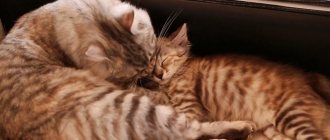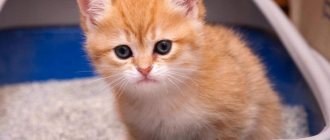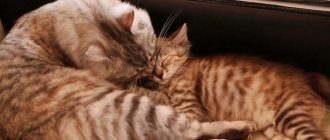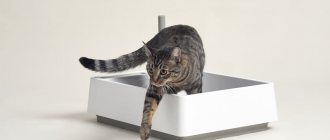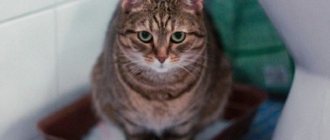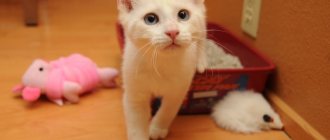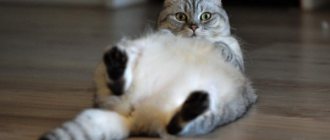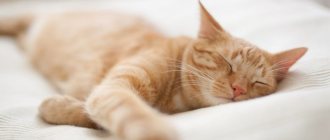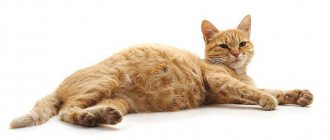How often do kittens go to the toilet? Do the owners think about this and monitor the number of urges? You can consult your veterinarian about this or read this article.
Kittens can pee 5 to 10 times a day depending on their age. The older the animal gets, the less often it goes to the toilet. If the number of visits to the tray is reduced to 4 or less times, this is a reason to consult a doctor. A kitten whose urine contains blood and mucus requires qualified help.
General information about the kitten's toilet
How long should a kitten poop? It is important to know the rate of bowel movements in order to protect your furry baby from health problems.
One month old kittens can poop on their own 3-6 times a day. When changing place of residence, the pet may not poop for about 5 days. After an adaptation period, the stool usually returns to normal, otherwise it is worth taking action.
You can give your pet a light massage of the abdomen and groin area
For your information! The toilet of a newborn kitten is under the complete control of the mother cat. The first three weeks after birth, the cat licks the baby. At the same time, not only body hygiene is observed, but also stimulation of blood circulation and the functioning of the digestive organs.
While licking, the cat uses its rough tongue to massage the belly and groin area. Thus, the sphincter of the anus and the urinary canal are irritated and relaxed, resulting in urination and defecation. The cat licks all the discharge, so the owners cannot detect traces of the kittens’ bowel movements for the first time after their birth.
Sometimes inexperienced females do not properly care for their babies. Your kitten may suffer from a bloated belly where feces and gases have accumulated. The owner can come to the aid of the baby. It is enough to take a brush, bandage or a little cotton wool and gently massage the groin area. This will help the kitten go to the toilet and get rid of discomfort.
To improve digestion and remove gases, you should massage your stomach using circular movements.
What causes urinary problems?
Changes in urination norms can be both harmless and directly indicating the development of diseases.
Non-hazardous reasons:
- stress caused by global changes in life (change of climate, place of residence, owners, “moving” other animals into the apartment, fear, etc.);
- sudden transition to another diet;
- castration, sterilization.
These reasons lead to pets becoming depressed and having a hard time with sudden changes in their lives, which leads to malfunctions of organs, including the urinary system. Typically, restoration of functions occurs in males within 3 days, in females – a little longer, but everything goes away without medical help. Cats are quickly adaptable animals, so getting used to new things does not take much time and does not have time to seriously harm their health. And if pets normally have to pee 2-3 times a day, then this will soon happen, despite the stress they have suffered.
How often should a kitten poop: normal bowel movements by age
When do kittens start going to the toilet on their own?
How many times a day should a kitten go to the toilet? Normal bowel movements depend on many factors. One of the main ones is age. The gender of the kitten and its health status are also important.
- at the age of 1-21 weeks, the norm of bowel movements is 3-4 times;
- at the age of 3 to 6 months - 2-3 times;
- over the age of 6 months - 1-2 times a day.
Three-week-old kittens should normally be fed their mother's milk with the gradual addition of solid food. Their feces have a thick and mushy consistency without foreign impurities. There should also be no undigested pieces of food in the stool. A deviation from the norm is considered to be too loose or too dry stool.
The older the kitten, the less often he defecates.
Adult kittens up to three months old are transferred to adult food. As a result, the nature of their bowel movements changes. The feces take on clearer shapes and become thicker. The frequency of visiting the tray depends on the nature of the food. When eating plant fiber, bowel movements occur more often, unlike animals, whose food mainly consists of protein.
Important! The feces of a three-month-old kitten should be of medium thickness without foreign impurities. Too frequent bowel movements or loose stools indicate some kind of disorder in the body.
Females and males go to the toilet differently. Cats pee more often. This is due to the physiological characteristics of the urinary tract. In males they are narrower and longer than in females. If your cat's diet is rich in fiber, he may go to the toilet more often.
How to deal with the problem of constipation in a kitten at home?
First you need to determine the cause of the problem.
Diet changes may be required. It is recommended to consult with the breeder to find out what food is best for your chosen breed.
A light massage in the abdominal area is recommended. The kitten's abdomen should be massaged with light circular movements. You cannot press or use force: this can seriously harm the cub.
If the diet is unbalanced and there are no contraindications, the use of an enema is allowed.
Medicines may be required. You should not select them yourself; it is better to consult a veterinarian. The use of laxatives is effective.
You can add a small amount of sunflower oil to your kitten's food. Vegetable fats will act as a laxative on the cat’s body.
If all measures have been tried, but the number of times a day your kittens defecate is not normal, treatment at a veterinary clinic may be required. Sometimes surgical intervention is necessary. Possible blockage caused by foreign body entering the intestines, severe pathologies of the digestive system.
How often should kittens pee?
How long do pregnant cats walk for the first time?
Veterinarians give owners of small kittens a simple rule that helps determine normal urination in their pets. The essence of the rule is that the amount of fluid entering the body must be equal to the fluid excreted in the urine. The baby has a small bladder, so he will go to the toilet in a small way more often than an adult cat.
The rate of urination also depends on the age, gender and health status of the children:
- at the age of 1-21 weeks, a kitten can pee about 3 times a day;
- animals 3-6 months old defecate 6-10 times;
- Pets older than 6 months pee on average up to 5 times.
With the introduction of complementary foods, kittens can be litter trained
When visiting the toilet, the owner must monitor the quality of urine. You need to pay attention to color, transparency, the presence of blood or mucus impurities. It is also worth noting the process of urination. Normally, it should be comfortable and painless for the baby.
How should an adult kitten go to the toilet?
From one month to three months of age, the kitten must be completely transferred to the usual diet of an adult. As the nature of nutrition changes, so does the nature of feces.
The feces become more shaped and thick. The number of trips to the toilet, as well as the type of feces, at this age depends on what the baby eats. If the food contains a lot of plant fiber, then the process of defecation will occur more often than if protein ingredients predominate in the diet.
In a one- or three-month-old kitten, you should rather pay attention not to the number of acts of defecation, but to the quality of the feces itself. The main thing is that it is more or less thick without any admixtures of blood, mucus, or foreign inclusions. Well, and of course, going to the potty too often with very liquid feces definitely indicates that something has gone wrong.
Pathological deviations from the norm
The cat often goes to the toilet a little at a time
The animal may experience abnormalities in normal urination. Veterinarians distinguish between safe and pathological cases. Safe ones include:
- stress caused by moving or the appearance of a new pet or stranger in the house;
- acclimatization;
- change of feed;
- procedure of castration, sterilization or other surgical operations.
All these factors are temporary. After an adaptation period, the number of urinations returns to normal.
You should take full responsibility for kittens who have begun to go to the toilet less often for more serious reasons. Such children usually exhibit abnormalities resulting from the development of various pathologies. If the cat cannot pee for more than two days, or the process itself causes her pain, or the amount of urine is very small, then it’s time to seek help.
The main cause may be an inflammatory process in the genitourinary organs. Signs of pathology are:
- plaintive meowing when urinating or inability to go to the toilet;
- presence of traces of blood, sand or mucus in the urine;
- lack of urination;
- scanty discharge;
- lack of appetite, apathy;
- increased body temperature;
- swollen belly;
- dry and hot nose and ears.
Deviations from the norm can be caused by pathologies in the body
If there is difficulty urinating, the kitten may take a characteristic position while in the tray. It is worth remembering that an animal may not go to the toilet if it is dirty or if it does not like the litter in the tray. Pathological deviations from the norm require immediate contact with a veterinarian. If you let the situation take its course, the kitten may die.
Preventing constipation in kittens
You need to avoid excess protein, select high-quality dry food, or prepare your own food so that it is balanced. The first weeks after the move, you should give the same food that the cat is accustomed to from the breeder. Babies fed on natural food should not be suddenly switched to dry food. Cats go to the toilet more often if they have enough fiber in their diet. The animal should always have access to clean water.
Active games with your pet will be beneficial. You don't want your cat to become too passive. To interest your pet, you should buy different toys.
Small objects should not reach the cat. If there is a child at home who scatters small beads and toys, you should clean up what is scattered after him. Objects can become lodged in the intestines, causing partial or complete blockages that sometimes result in the death of the pet.
It is recommended to regularly show the animal to a veterinarian. Examinations will help detect pathologies in the early stages and take timely measures.
All information posted on the site is provided in accordance with the User Agreement and is not a direct instruction to action. We strongly recommend that before using any product, you must obtain a face-to-face consultation at an accredited veterinary clinic.
What to do if there are deviations
Violation of the frequency of toilet visits by a small kitten is usually associated with stressful situations. Such factors disappear by themselves when the animal goes through an adaptation period. The situation is more complicated when urination is impaired due to health problems. In this case, the kitten can either walk too often or too rarely.
Frequent urination
If a kitten pees frequently, then most likely he has developed cystitis, a disease of the urinary organs, or urolithiasis. The baby will often run up to the tray, but the volume of urine will be catastrophically small. Sometimes there is blood in the urine.
Frequent urges can be caused by drinking too much in hot weather, as well as diabetes. Urinary incontinence is accompanied by a large amount of fluid released and no bleeding. The same signs are characteristic of marking territory.
Cystitis most often occurs in adult kittens. The reasons may be:
- drafts;
- sand in the kidneys;
- impaired metabolism;
- mineral imbalance;
- sexual infections;
- predominance of dry food, lack of liquid and proteins.
Deviations from the norm should be studied and treated in veterinary clinics
Cats of any age can get urolithiasis. Signs of the disease are:
- unsuccessful visit to the tray;
- a tiny amount of urine;
- presence of blood in the urine;
- vomiting and high fever;
- lethargy and apathy.
There are cat breeds that are genetically predisposed to this disease. Among them are Scottish Fold, Persian and Siamese breeds.
Also, frequent urination can be associated with diabetes, stress or enuresis. In any case, assistance to the pet must be qualified and timely. If there is the slightest sign of a pathological condition, you should immediately contact a veterinarian. He will prescribe a number of diagnostic measures and adequate treatment.
A kitten who pees frequently will undergo the following tests:
- blood biochemistry;
- Analysis of urine;
- X-ray;
- comparison of the amount of urine and drink;
- Ultrasound;
- hormone test;
- determination of acetone levels and acid-base balance.
These types of studies will help to identify the nature of the disease of the genitourinary system, make a diagnosis and decide on treatment.
In addition to adequate therapy, it is important to carry out a number of preventive measures for the full functioning of the genitourinary system. Regular medical examinations, proper diet, physical activity, and the optimal amount of drinking will ensure normal urination and healthy urinary tract of the kitten.
Too infrequent visits to the litter box
Rare urination is just as dangerous to a kitten's health as frequent urination. In such situations, the main cause is pathological processes, both in the genitourinary system and in the body as a whole. Almost 75% of cases of insufficient urine flow or insufficient discharge occur due to cystitis. Lack of proper treatment will invariably lead to a condition such as acute urinary retention.
Having such a diagnosis, a kitten may not walk for more than a day. This is a dangerous phenomenon that often ends in death. The bladder becomes full and bursts. Urine enters the abdominal cavity, which can lead to intoxication of the body and death of the pet.
Kittens need to be fed crushed food.
The pathology most often occurs in male kittens. For females, such a disease is not typical, although it is also sometimes detected. The main cause of the disease is stones that block the urinary tract. Experts identify other factors:
- blockage of the urethra by a blood or mucus clot. Occurs against the background of trauma to the genital organ or an infectious disease, in particular the bladder;
- abnormal kidney function. With renal dysfunction, the kitten’s body can no longer excrete urine even in minimal volumes. The cause may be a malignant tumor or perforation of the kidney;
- spinal injury or infectious disease affecting the spinal cord. The absence of a nervous connection between the genitourinary organs and the spinal cord leads to disruption of their functioning and the cessation of urination of the animal.
Urinary retention of any stage requires urgent treatment. In the clinic, a kitten may be prescribed the following procedures:
- catheterization using a special catheter that is inserted into the urethra. This will help empty your bladder;
- surgical intervention. Prescribed in case of ineffectiveness of repeated catheterization.
To prevent advanced cases of impaired urination, the owner of kittens must take preventive measures daily:
- animals must receive anti-infective vaccinations on a schedule;
- avoid hypothermia;
- provide access to an unlimited amount of fresh and clean water;
- the diet must comply with the kitten’s nutritional rules according to its age;
- an active lifestyle and outdoor games will also be beneficial.
For any pathological conditions or deviations from the norm, it is prohibited to prescribe medications yourself. Kittens must be treated by a veterinarian. He will also tell you how many times a kitten should poop and pee per day. This will keep your little pet healthy and alive.
Accustoming a kitten to adult food and litter tray
Starting from the 22nd week of a kitten’s life, it can be gradually introduced to complementary foods. To do this, you can use special canned food for kittens. If food is prepared independently, then the baby should be given it chopped. Gradually, the amount of mother's milk in the kitten's diet decreases, and it completely switches to adult food. At this time, his feces change their structure and shape. They become more formed and dense. At the same time, it is advisable to start accustoming your baby to the tray. The toilet should be placed next to the box where he lives and sleeps. The sides of the tray should be low so that the baby can climb into it himself. It is better to choose crumbly filler. This will help the kitten develop a digging reflex and get used to the toilet.
The frequency of replacing the litter in the tray depends on how often the kittens poop and pee.
The ideal option would be to help a mother cat. Kittens willingly follow the example of adults. If a cat goes to the litter box when the baby is present, the kitten will quickly learn to do this on its own. Over time, the tray can be moved to another more suitable location.
Signs that a kitten wants to go to the toilet
Many owners have kittens growing up without a mother cat. In such cases, training and litter box training are the responsibility of the owner. First of all, a person should know when the kitten wants to go to the toilet. At this moment, the animal gives specific signs. It's important to just keep an eye on it. The baby wants to go to the toilet if:
- scratches on the floor and other objects;
- sniffs everything around, looking for a place to defecate;
- stomps around in one place, meows subtly and sits down;
- With a strong desire to go to the toilet, the kitten's eyes become glassy. The owner should know that the baby urgently needs to be placed in the tray.
Tray training should be leisurely. It is important to change the litter on time, as the kitten may refuse to go to a stale toilet. Do not neglect to pay attention to the feces and urine of the animal, to see if there are any foreign impurities, pus, worms, blood or mucus. Timely identification of the problem and contacting a veterinarian will prevent the occurrence of serious diseases and complications, which in the future can lead to intractable health problems and even the death of a small pet.
Polo Modis
599 ₽ More details
Polo Modis
499 ₽ More details
Modis backpacks
